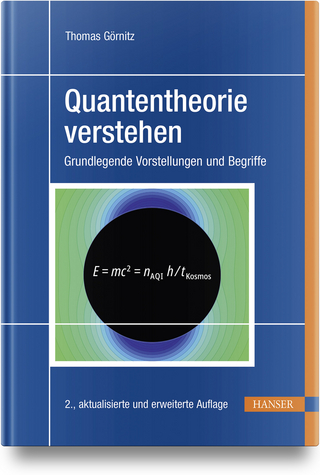
Physical Processes in Lasers
Kluwer Academic/Plenum Publishers (Verlag)
978-0-306-10884-6 (ISBN)
- Titel ist leider vergriffen;
keine Neuauflage - Artikel merken
Dependence of the Width and Shape of the Giant Pulse on the Population Inversion Coefficient...
Mode Discrimination and the Self-Locking Effect in Solid-State Lasers Using a Bleachable Filter A. S. Markin.- 1. Q Switching of Lasers by Means of a Passive Shutter.- 1. Operating Principle and Types of Passive Shutters.- 2. Q Switching of Neodymium Glass Lasers by Means of a Bleachable Liquid Filter.- 3. Dependence of the Width and Shape of the Giant Pulse on the Population Inversion Coefficient.- 2. Spectral Composition of Solid-State Laser Emission and Mode Discrimination by Various Cavity Elements.- 1. Spectral Composition of Solid-State Laser Emission.- 2. Mode Discrimination in Neodymium Glass Lasers with a Passive Shutter Due to Fresnel Reflection at the Ends of the Active Rod.- 3. Selective Properties of Various Cavity Elements and Their Influence on the Emission Spectrum of Solid-State Lasers.- 3. Development of the Emission Pulse in the Case of Passive Switching.- 1. Giant-Pulse Buildup in a Q-Switched Laser.- 2. Determination of the Giant-Pulse Buildup Time in a Neodymium Glass Laser with a Passive Shutter.- 3. Determination of the Buildup Time for a Free-Oscillation Spike in a Neodymium Glass Laser.- 4. Self Mode Locking in a Solid-State Laser Using a Bleachable Filter.- 1. Theoretical Model of the Self-Locking Process.- 2. Dependence of the Self-Locking Effect on the Position of the Bleachable Filter in the Cavity.- 3. Self-Locking in Neodymium Glass and Ruby Lasers with a Bleachable Filter in the Case of a Broad Emission Spectrum; Ultimately Narrow Width of Ultrashort Pulses in Lasers of This Type.- Literature Cited.- Detection and Investigation of Stimulated Emission in a Pinched Discharge V. M. Sutovsk.- 1. State of the Art of Pulsed Ionic Laser Research.- 2. On the Creation of Negative-Temperature States in a Pinch-Discharge Plasma.- 1. Physical Processes in a Pinch Discharge.- 2. Possible Mechanisms of the Formation of Negative-Temperature States in the Pinch-Discharge Plasma.- 3. On the Experimental Program.- 3. Investigation of the Characteristics of a Pinch Discharge.- 1. Description of the Experimental Setup.- 2. Discharge Electrotechnical Parameters.- 3. Probe Measurements of Current Distribution over the Discharge Tube Cross Section.- 4. High-Speed Photoscanning of Pinch Radiation.- 5. Discharge Spectral Characteristics.- 4. Properties of Stimulated Emission in a Pinch-Discharge Plasma at the Transitions of Singly and Doubly Ionized Argon Atoms.- 1. Properties of Emission by Ar II Ions.- 2. Emission at Ar III Transitions in the Ultraviolet Spectral Region.- 3. Emission in Subsequent Discharge Current Half-periods.- 4. Emission at the 4764.89A Line for Discharge Current Pulses Having a High Repetition Rate.- Chapters 5. Determination of the Parameters of the Pinch-Discharge Plasma.- 1. Theoretical Foundation of the Applicability of Plasma Diagnostic Methods.- 2. Measurement Procedure and Results.- 3. Feasibility of Plasma Diagnostics Based on the Self-Induced Emission of a Pinch Discharge.- Discussion.- Literature Cited.- Physical Processes in Molecular Hydrogen, Deuterium, and First-Positive-Band-System Nitrogen Pulsed Gas-Discharge Lasers I. N. Knyaze.- 1. State of the Art of Research on Pulsed Gas-Discharge Lasers; Statement of the Problem.- 1. General Description of Pulsed Gas Laser Research.- 2. Brief Survey of the Literature on Lasers Operating on Electron Transitions in Diatomic Molecules; Statement of the Problem.- 2. Experimental Methodological Problems.- 1. The Laser and Its Excitation Circuit.- 2. Spectral Measurements.- 3. Gas-Discharge Measurement Technique.- 3. Pulsed Emission from H2, D2, and HD Molecules.- 1. The Stimulated Emission Spectrum.- 2. Electron States and Transitions in H2, D2, and HD Molecules; Qualitative Inversion Mechanism.- 3. Singular Characteristics of the Excitation of Rotational Spectral Structure in Hydrogen and Deuterium Lasers.- 4. Temporal and Energy Characteristics of the First-Positive-Band-System Molecular Nitrogen Laser.- 5. Stimulated Emission Spectrum of the N2(+1) Laser and Interpretation of the Vibrational-Rotational Structural Features of this Spectrum.- 1. The Stimulated Emission Spectrum.- 2. Electron States and Transitions in N2; Analysis of Excitation of the Vibrational and Rotational Structure of the Laser Emission Spectrum.- 6. Aspects of the. Physics of Pulsed Discharge.- 1. Pulsed-Discharge and Inversion Dynamics of the N2(+1) Laser.- 2. Temporal Evolution of the High-Current Discharge Phase; Physical Model of Discharge.- 7. Population Dynamics of the Upper Laser Levels in the 1+ Band System of N2.- 1. On the Excitation Mechanism for the Upper Laser Levels.- 2. Critical Analysis of the Mechanism of Step-by-Step Filling of the Laser Levels.- 3. Lasing Cutoff Mechanism; Simplified Laser-Level Diagram.- 8. Elementary Quantitative Theory of Laser Action in the 1+ Band System of N2.- 1. Population Inversion Dynamics.- 2. On the Ultimate Laser Power.- 3. Ultimate Efficiency of the N2(1+) Laser.- Conclusion.- Literature Cited.
| Reihe/Serie | The Lebedev Physics Institute Series ; 56 |
|---|---|
| Zusatzinfo | biography |
| Sprache | englisch |
| Themenwelt | Naturwissenschaften ► Physik / Astronomie ► Quantenphysik |
| Technik | |
| ISBN-10 | 0-306-10884-4 / 0306108844 |
| ISBN-13 | 978-0-306-10884-6 / 9780306108846 |
| Zustand | Neuware |
| Haben Sie eine Frage zum Produkt? |
aus dem Bereich


